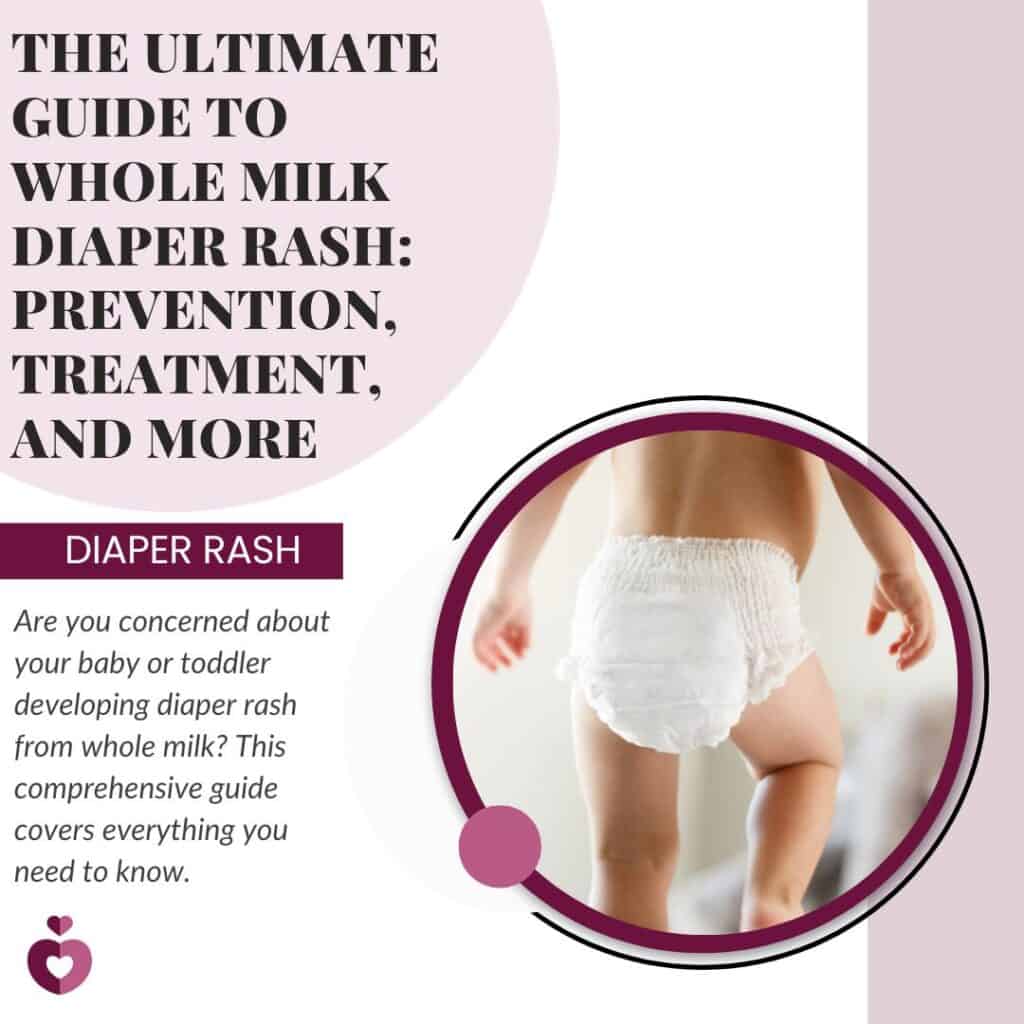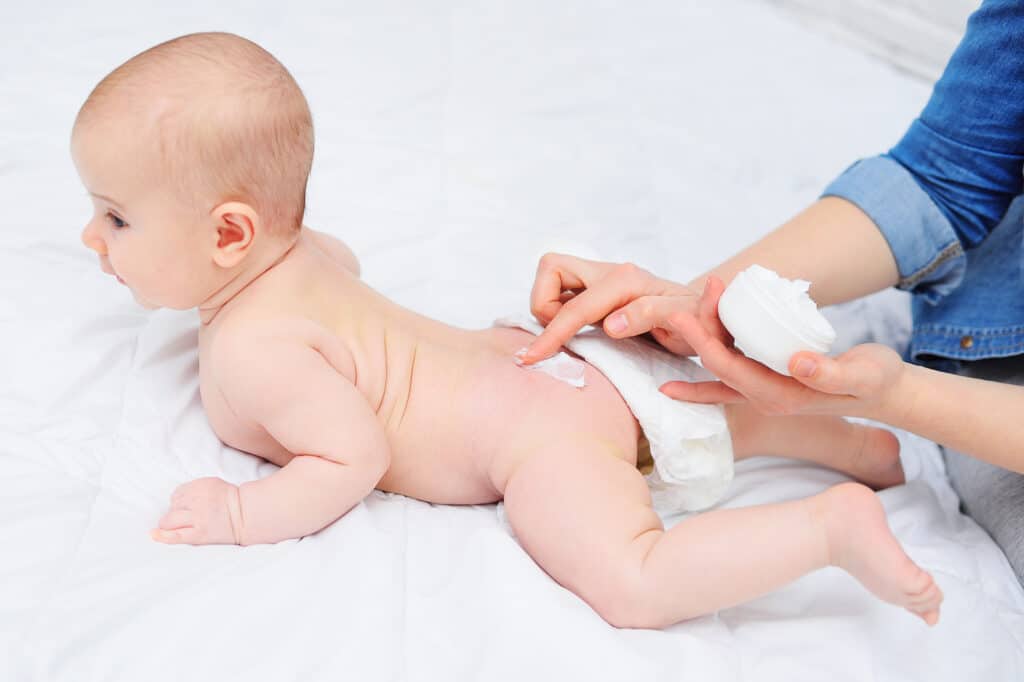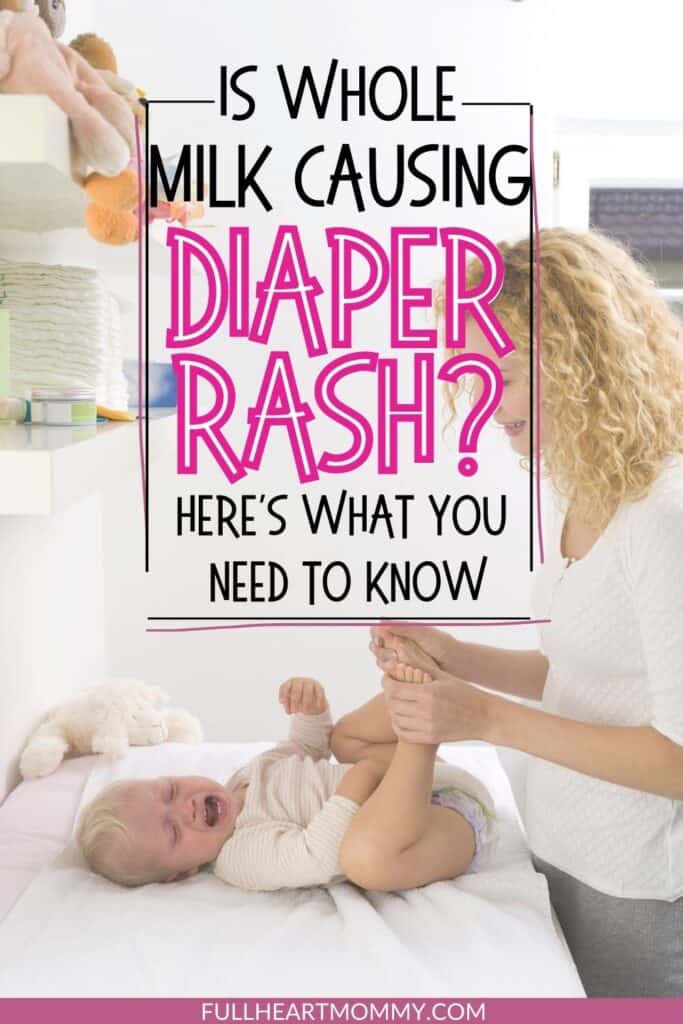As your child continues to grow, you’ll inevitably have to introduce them to various food and beverages – whole milk being one of them. However, whole milk has been a topic of discussion among many moms, parents, and caregivers, partly due to its connection with diaper rash in babies and toddlers.
Diaper rash, a common skin irritation found in infants and toddlers, occurs when the diaper area is consistently moist from urine or stool. This can lead to redness, swelling, and discomfort for your little one.
In this blog post, we’ll delve into the link between whole milk and diaper rash, addressing your queries and concerns, and helping you make informed decisions for your child’s health.

Can Whole Milk Cause Severe Diaper Rash?
Whole milk is a type of dairy that is not processed or skimmed in any way. It is rich in essential nutrients, such as calcium, vitamin D, and protein, and is often recommended to support healthy bone development in infants and children.
Whole milk can also cause severe diaper rash in babies due to the high amounts of fat in the milk.
According to some studies, it’s best to avoid giving whole milk to infants less than one year old as their immature digestive systems can’t handle the large protein molecules that can cause trouble for some babies.
For some babies, the introduction of whole milk to their diet may result in a temporary bout of diarrhea, which can subsequently trigger diaper rash.
Diarrhea can lead to irritation and inflammation of your baby’s delicate skin, especially if they’re sitting in a soiled diaper for an extended period.
Additionally, some children may also be allergic to the protein in whole milk which can lead to an unpleasant reaction that can cause severe diaper rash.
Can Cow’s Milk Cause Diaper Rash?
While cow’s milk and whole milk are often used interchangeably, it’s important to note that they’re not the same thing. When cow’s milk is processed, it undergoes homogenization and pasteurization, which can change its composition.
As for whether cow’s milk can cause diaper rash – it may be possible in some cases depending on the baby’s sensitivity to lactose and how his or her digestive system processes it.
Can Switching from Breastmilk to Whole Milk Cause Diaper Rash?
There are a few reasons why some parents may decide to switch their baby from breastmilk to whole cow’s milk. Some need help with the cost of formula and opt for cow’s milk instead; others believe that their child’s iron levels would benefit from the higher iron content in animal-based milks (like cow’s milk); or they simply want a break from breastfeeding and use another form of feeding as an alternative.
Now onto the question: Can switching from breastmilk to whole milk cause diaper rash? To answer this question, we must look at what causes diaper rash in general — usually, internal factors like food allergies, as well as external factors such as chemicals in skin care products and detergents used on diapers can trigger rashes too.
It should also be noted that Cow’s Milk Allergy (CMA) is one potential cause which could explain why a child develops a diaper rash after drinking whole cow’s milk if they previously drank exclusively breastmilk before switching over.
Studies even support this finding – One 2016 study published by Pediatric Dermatology found that 16%~25% of infants with CMA had signs of skin irritation caused by the allergen present in cows’ milk.
Also worth noting: research has shown an association between CMA symptoms worsening when infants are given cows’ milk formula compared to those who were exclusively fed with human breastmilk.
As always though – if you think your infant may be experiencing any allergic reactions due to consuming cows’ milk products please consult your pediatrician for diagnosis/treatment options first before making any dietary changes yourself.

Can Lactaid Milk Cause Diaper Rash?
Lactaid milk can cause diaper rash if your baby is lactose intolerant. If your baby drinks Lactaid milk and is sensitive to lactose, then it could cause an allergic reaction in the form of diaper rash.
While there is some connection between the introduction of whole milk and diaper rash in infants and toddlers, it’s worth mentioning that not all babies will experience this issue. It’s essential to monitor your little one closely during this transition and seek professional advice if you have concerns about their well-being.
What are the Side Effects of Switching Babies to Whole Milk?
As your little one reaches their first birthday, you may start thinking about switching them to whole milk.
While milk is a great source of calcium and other nutrients, there are some side effects to consider. Aside from the possibility of diaper rash, babies who switch from breastmilk to whole milk may experience:
– Lactose intolerance
– Constipation
– Gas
– Bloating
In most cases, these symptoms are temporary and subside once the child’s digestive system adjusts.
Side effects can occur when introducing any new food to your baby’s diet, including whole milk. But don’t worry! There are ways to minimize these side effects.
Start by introducing whole milk slowly, mixing it with breast milk or formula at first. Begin with diluting their current formula by adding 1-ounce of whole milk per 4 ounces of prepared infant formula or breask milk. As the weeks progress you will gradually add more whole milk until they are on all whole milk.
Also, make sure your baby is getting enough water and fiber in their diet. Still offer age appropriate foods rich in iron, iodine and vitamin B12 like eggs, dairy products enriched cereals, fish such as salmon & tuna plus different legumes like lentils & beans. Additionally, well balanced meals should continue even once transitioned completely off infant formulas/breastmilk as these provide essential vitamins minerals proteins & fats needed for growth & development into toddlerhood.
Whole Milk Diaper Rash in Toddlers
Diaper rash can still be a common condition that affects most toddlers and occurs when their skin becomes irritated by prolonged exposure to urine and feces. It can cause redness, itching, and discomfort, making it difficult for toddlers to sleep, play, or even walk.
Excessive intake of whole milk may indeed increase the likelihood of developing diaper rash in toddlers. This is because whole milk contains fats that can lead to diarrhea and make the stool more acidic, making it easier for bacteria to thrive and cause irritation in the diaper area.
While this doesn’t mean you need to eliminate whole milk from your child’s diet altogether, it does suggest that moderation is key. Along with good diaper hygiene, choosing whole milk alternatives like almond or soy milk may also help prevent diaper rash in toddlers.
When Should You Be Concerned About A Diaper Rash?
While usually not serious and easy to treat, it’s important to be aware of the signs and symptoms so you know when it’s necessary to take your baby for medical attention.
Most cases of diaper rash will clear up on their own with proper hygiene and products formulated specifically for treating such issues–such as medicated ointments containing zinc oxide which acts as barrier cream between the skin and irritants found within diaper, or even DIY natural solutions like baking soda.
The first sign of diaper rash often appears as a slight redness in the affected area. But if left unchecked, this minor irritation can quickly turn into bright red skin accompanied by intense itchiness or pain.
Other than just being uncomfortable, some more severe cases can cause swelling or oozing sores that might indicate an infection has taken hold.
In addition to monitoring any changes in your baby’s discomfort level and appearance, here are some other things you should watch out for:
- fever (over 100 degrees Fahrenheit)
- difficulty urinating due to discomfort or tummy pain
- refusal to eat or drink due to excessive itching/pain near the diaper area
- presence of blisters filled with pus which could indicate a bacterial infection
If these signs appear—or if there is just no improvement after three days despite treatment—schedule an appointment with your pediatrician right away!
We hope this post has been informative and helpful in demystifying the link between whole milk and diaper rash in both babies and toddlers.
Please feel free to ask any questions or share your experiences in the comments section below. Happy parenting!


